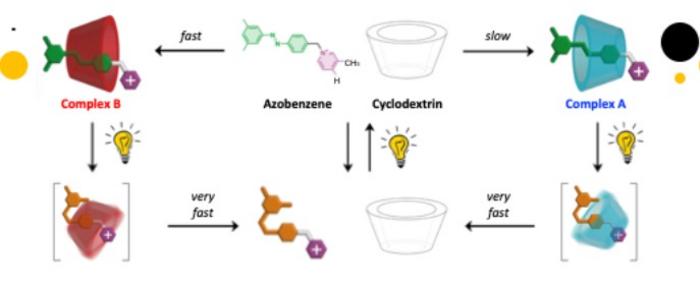Light-Driven Molecular Assembly: A Breakthrough in Nanotechnology
In recent years, the development of nanotechnology has opened new frontiers in various scientific fields, particularly in chemistry and materials science. A novel study undertaken by a research team led by Professor Alberto Credi at the University of Bologna showcases groundbreaking advancements in light-induced molecular assembly. This research intricately explores how photochemical reactions can effectively manipulate molecular interactions, leading to the formation of unique molecular structures that diverge from traditional thermodynamic pathways.
The essence of this research lies in the integration of cyclodextrins and azobenzene derivatives, two distinct yet complementary molecular systems. Cyclodextrins are known for their hollow, truncated cone shape, enabling them to encapsulate other molecules within their cavities. Azobenzene derivatives, on the other hand, are remarkable for their ability to undergo structural transformations when exposed to light. This property is critical because it allows these filiform azobenzene molecules to alternate between an extended and a bent configuration, influencing their interaction with cyclodextrins considerably.
Through meticulous experimentation, the research team demonstrated the potential of using light as a driving force in molecular assembly. Typically, in chemical systems at equilibrium, molecules tend to settle into the most thermodynamically stable states. However, by administering light energy, the researchers successfully created conditions that circumvented these equilibria, enabling a distribution of molecular complexes that would be unattainable under ordinary conditions. This phenomenon is particularly fascinating as it mirrors critical biological functions, especially those in living organisms that operate away from thermodynamic equilibrium.
The study employs visible light, specifically at a wavelength of 453 nm, as a clean and sustainable energy source to manipulate molecular assemblies. The implications of this approach are far-reaching, potentially transforming multiple fields ranging from nanomaterials development to medical applications. As per Professor Credi, this technique could lead to the design of innovative substances capable of dynamic responses to external stimuli, fundamentally reshaping our understanding of molecular behavior in artificial systems.
One of the pivotal findings of this research is the significant difference in the formation rates between the two complexes generated by the interactions between cyclodextrins and azobenzene derivatives. Complex A, which is more stable, forms at a slower rate compared to Complex B. This discrepancy becomes crucial under continuous illumination, where the rapid formation of Complex B dominates the system, allowing researchers to maintain a steady state that would favor this less stable yet kinetically favored product.
Moreover, the study elucidates the mechanism by which light-excited azobenzene molecules can dissociate from the cyclodextrin cavity. When the solution is irradiated, the azobenzene shifts from a conformation that fits the cyclodextrin cavity to a bent state incompatible with it, resulting in the release of the azobenzene from the cyclodextrin. Upon continuous exposure to light, this cycle of dissociation and reassembly leads to a dynamic equilibrium characterized by Complex B. Once the light source is removed, the azobenzene molecules revert gradually to their stable extended configuration, eventually leading to the re-establishment of Complex A.
This striking study not only illuminates new synthesis methodologies for creating dynamic molecular materials but also offers promising potential for developing novel devices, such as nanomotors and smart therapeutics. The ability to harness light in a manner that actively promotes non-equilibrium conditions presents an exciting avenue for research that bridges chemistry and biology, mimicking the complex mechanisms observed in living systems.
The collaborative nature of this research, involving multiple departments at the University of Bologna and international partners, emphasizes the importance of multidisciplinary approaches in advancing scientific knowledge. By bringing together expertise from industrial chemistry, agriculture, and food science, the team was able to generate insights that are likely to pave the way for next-generation molecular devices and machines.
The potential applications of this technology extend to the fields of medical therapeutics and environmental remediation, where responsive materials can play a transformative role. The development of smart drugs that interactively respond to biological changes represents just one of the many possibilities that could arise from this research. Such advancements can lead to personalized medicine strategies that are more effective and less harmful than traditional approaches.
This study has been published in the prestigious journal Chem, showcasing its significance in the scientific community. The work was supported by funding from the Ministry of University and Research, underlining its importance in advancing our knowledge of molecular dynamics and synthesis. The findings open new pathways not only in nanotechnology but also in how we perceive and utilize light in chemistry.
The implications of this light-driven molecular assembly are profound, potentially leading to transformative changes in both the scientific landscape and industrial applications. With ongoing research and development, it is likely that we will continue to see exciting innovations stemming from this fundamental understanding of molecular interactions.
Subject of Research: Light-induced molecular self-assembly
Article Title: Light-drive ratcheted formation of diastereomeric host-guest systems
News Publication Date: 27-Dec-2024
Web References: DOI link
References: Chem Journal
Image Credits: University of Bologna
Keywords





